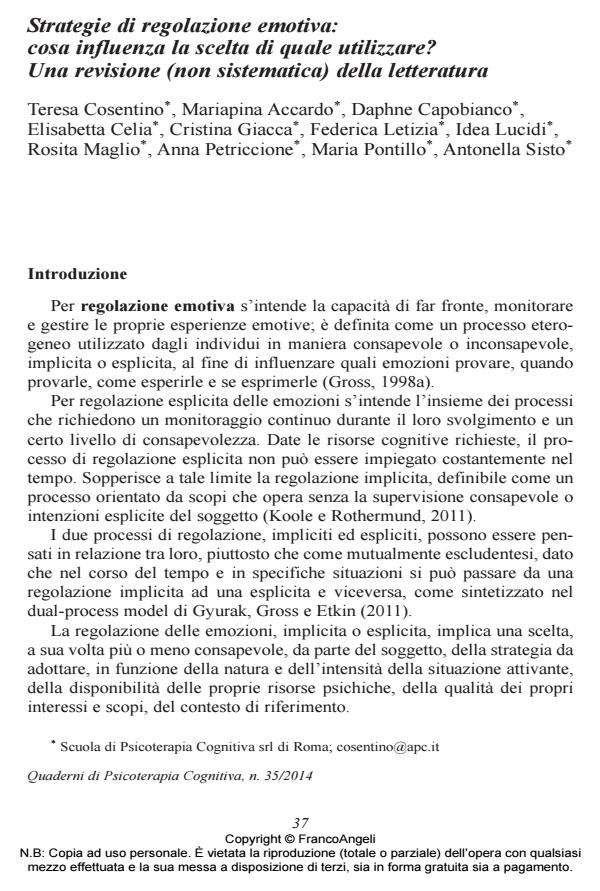Emotion Regulation Strategies: what does it determinate the choice of which of them to use? A non-systematic review of literature
Journal title QUADERNI DI PSICOTERAPIA COGNITIVA
Author/s Teresa Cosentino, Mariapina Accardo, Daphne Capobianco, Elisabetta Celia, Cristina Giacca, Federica Letizia, Idea Lucidi, Rosita Maglio, Anna Petriccione, Maria Pontillo, Antonella Sisto
Publishing Year 2014 Issue 2014/35
Language Italian Pages 19 P. 37-55 File size 76 KB
DOI 10.3280/QPC2014-035003
DOI is like a bar code for intellectual property: to have more infomation
click here
Below, you can see the article first page
If you want to buy this article in PDF format, you can do it, following the instructions to buy download credits

FrancoAngeli is member of Publishers International Linking Association, Inc (PILA), a not-for-profit association which run the CrossRef service enabling links to and from online scholarly content.
Emotion regulation (ER) is a heterogeneous set of processes that involve changes in the experiential, behavioural and physiological response systems. Experimental data show that subjects flexibly using different strategies of RE have a better long-term adjustment (Mauss and Gross, 2004). Most people are able to regulate negative emotions; on the other hand, the majority of mental disorders imply emotion dysregulation. What prevents the flexible use of emotion regulation strategies? This question prompted the authors in this non-systematic review of the extant literature on the variables that influence the use of the different strategies. It stands out how much this choice is influenced by factors such as social desirability, age, gender, personality traits, subject’s beliefs about modifiability of the emotional experience, and goals pursued. However, the works consulted not allow you to answer to the question exhaustively. According to the authors, to determine the choice, more or less conscious strategy to use for the RE could be the belief system of the person about the "how and when" expressing/experiencing certain emotions in connection with the values and goals that you pursue.
Keywords: Emotion regulation strategies, emotions, goals, values, emotional regulation.
Teresa Cosentino, Mariapina Accardo, Daphne Capobianco, Elisabetta Celia, Cristina Giacca, Federica Letizia, Idea Lucidi, Rosita Maglio, Anna Petriccione, Maria Pontillo, Antonella Sisto, Strategie di regolazione emotiva: cosa influenza la scelta di quale utilizzare? Una revisione (non sistematica) della letteratura in "QUADERNI DI PSICOTERAPIA COGNITIVA" 35/2014, pp 37-55, DOI: 10.3280/QPC2014-035003